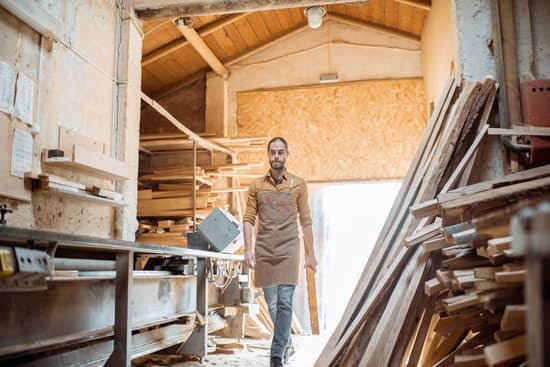In the world of woodworking, lumber is a fundamental component that serves as the building block for countless projects. Whether you’re crafting furniture, creating intricate carvings, or constructing a wooden structure, having a thorough understanding of lumber is essential for successful woodworking endeavors.
This article will delve into the intricacies of lumber woodworking, starting with a brief overview of its importance within the craft. We will explore why understanding lumber is crucial for achieving desired results in woodworking projects.
Before diving deeper into the topic, it’s important to establish what exactly lumber is in the context of woodworking. We will define this key term and highlight the various types of lumber commonly used by woodworkers, including hardwoods, softwoods, and exotic woods.
Furthermore, we will examine the anatomy of lumber, focusing on aspects such as grain pattern and figure that greatly impact both the appearance and workability of wood. Understanding moisture content in lumber will also be explored since it plays a significant role in the woodworking process.
Sourcing quality lumber for woodworking projects can be a challenge for many craftsmen. This article will provide a guide on where to find reliable sources and offer practical tips for selecting suitable lumber based on specific project requirements while considering factors such as size, species, quality, and budget.
Once you have obtained your desired stock of lumber, proper preparation and milling are necessary to ensure its readiness for use in woodworking projects. Step-by-step instructions on preparing rough-sawn lumber and an overview of key milling techniques such as jointing, planing, and ripping will be provided.
Working with lumber involves various techniques such as shaping, cutting, and joining. Throughout this article series, we will explain these techniques in detail while highlighting essential tools and machinery needed to accomplish different tasks involving lumber.
However, like any craftwork, challenges are bound to arise when working with lumber. Issues such as warping or cupping can jeopardize the quality of your woodworking project. This article will identify common challenges faced by woodworkers and offer practical tips and solutions to overcome or minimize these obstacles.
Safety is paramount when working with lumber in any woodworking environment. We will emphasize the importance of implementing proper safety precautions, using personal protective equipment (PPE), and following best practices to ensure a safe working environment for all woodworking enthusiasts.
By mastering the art of lumber woodworking, you open up a world of creative possibilities in your craft. Stay tuned as we delve further into the fascinating realm of lumber woodworking, empowering you to embark on exciting projects with confidence and skill.
The Definition and Types of Lumber in Woodworking
Lumber is a fundamental component of woodworking, serving as the raw material from which many projects are crafted. In the context of woodworking, lumber refers to processed wood that has been cut and shaped into various sizes and dimensions for use in construction or crafting. Understanding the different types of lumber is essential for successful woodworking projects.
There are several types of lumber commonly used in woodworking, each with its own unique characteristics and properties. Hardwood and softwood are two broad categories of lumber based on the type of tree they come from. Hardwood comes from deciduous trees, such as oak or walnut, while softwood comes from coniferous trees like pine or cedar.
Hardwoods are known for their durability and strength, making them suitable for furniture-making or intricate woodworking projects. Softwoods, on the other hand, are more abundant and less expensive, often used in construction or outdoor projects due to their natural resistance to decay.
Exotic woods may also be used in certain woodworking projects for their distinctive appearance or enhanced properties. These woods come from trees found in regions outside of North America and Europe, such as mahogany from South America or teak from Southeast Asia. Exotic woods offer a wide range of colors, grain patterns, and textures that can add unique aesthetics to finished products.
When working with different types of lumber, it is important to consider factors such as density, moisture content, and stability. Hardwoods typically have a higher density than softwoods and require specific techniques when cutting or shaping due to their density.
Understanding the anatomy of lumber plays a crucial role in producing high-quality woodworking pieces. The grain pattern refers to the arrangement of fibers within wood and can greatly impact both the appearance and workability of lumber. Figure describes any distinctive patterns or visual effects found within the wood’s grain.
Moisture content is another critical consideration when working with lumber. Wood expands and contracts depending on its moisture level, affecting its stability. It is important to know the moisture content of the lumber before starting a project to ensure proper joinery and minimize the risk of warping or shrinking after construction.
Overall, having a solid understanding of the different types of lumber and their characteristics is vital in woodworking. By choosing the appropriate type and quality of wood for a given project, woodworkers can enhance the beauty and durability of their creations.
The Anatomy of Lumber
In order to truly master the art of lumber woodworking, it is crucial to have a deep understanding of the anatomy of lumber. This section will delve into the intricate details of grain patterns, figure, and moisture content and how they impact the appearance and workability of wood.
Grain patterns play a significant role in determining the final look of a woodworking project. The grain refers to the direction in which wood fibers run within a piece of lumber. It can be categorized as either straight-grained or irregular-grained.
Straight-grained wood with consistent fibers is generally easier to work with and less prone to splitting or warping. On the other hand, irregular-grained wood can provide unique visual appeal but may require more careful planning and skill when working with it.
Figure refers to the natural patterns or markings found on certain types of wood that make them visually distinctive. These markings can include swirls, curls, knots, or contrasting colors in the grain. Figure can add beauty and character to woodworking projects and is often sought after for aesthetic purposes. However, figuring can also pose challenges during shaping and finishing due to its irregularities.
Moisture content is another crucial aspect of lumber anatomy that heavily influences woodworking projects. When trees are felled, they contain a significant amount of moisture which gradually evaporates during drying. The moisture content affects not only the weight and strength of wood but also its dimensional stability.
Wood with higher moisture content tends to shrink and expand more significantly when exposed to changes in humidity levels. Therefore, it is essential for woodworkers to understand and consider moisture content when selecting lumber for their projects.
In summary, understanding the anatomy of lumber – including grain patterns, figure, and moisture content – is fundamental for successful woodworking projects. By carefully considering these factors during material selection and planning stages, woodworkers can create pieces that not only showcase the natural beauty of the wood but also possess the desired characteristics for their intended purpose.
Sourcing and Choosing Lumber for Woodworking Projects
Sourcing Quality Lumber
When it comes to woodworking projects, sourcing quality lumber is essential for achieving successful and durable results. There are several options available for obtaining lumber, and understanding the different sources can help you choose the best option for your project.
One common source of lumber is local lumber yards or home improvement stores. These establishments often carry a variety of wood species and cuts that are suitable for woodworking projects. Additionally, they may have knowledgeable staff who can assist you in selecting the right type of lumber based on your project requirements.
Another option for sourcing lumber is specialty suppliers or mills that specifically cater to woodworking enthusiasts. These suppliers often offer a wider selection of wood species, including more unique and exotic woods. While these specialty suppliers may have higher prices compared to larger stores, they can provide access to high-quality and rare lumber options.
For those looking to save costs or embrace sustainability, salvaged or reclaimed wood can be an excellent choice. Salvaged wood comes from various sources such as old structures, decommissioned ships, or fallen trees. Using salvaged wood not only adds character to your project but also reduces waste and promotes environmental conservation.
Tips for Choosing the Right Lumber
Choosing the right lumber involves considering several factors such as size, species, quality, and budget. Here are some tips to help you make informed decisions when selecting lumber for your woodworking projects:
- Size: Determine the dimensions required for your project beforehand to ensure you get appropriately sized lumber.
- Species: Different wood species have distinct characteristics that affect durability, appearance, and workability. Research the characteristics of various species to find one that suits your project’s needs.
- Quality: Inspect each piece of lumber carefully before purchasing by checking for any defects like knots, cracks, twists, or warping that could affect its usability in your project.
- Budget: Have a clear understanding of your budget and balance it with the quality and quantity of lumber required for your project. It may be worth investing in higher-quality lumber for critical components, while less expensive options can be used for non-visible parts.
Remember to communicate your project requirements with the lumber supplier or mill personnel to help them guide you in choosing the appropriate lumber. By sourcing and selecting quality lumber, you are laying the foundation for a successful woodworking project.
Preparation and Milling
Preparing and milling lumber is an essential step in woodworking projects as it ensures that the wood is ready to be shaped and joined. This section will provide step-by-step instructions on how to prepare rough-sawn lumber for woodworking, as well as an overview of different milling techniques.
The first step in preparing lumber for woodworking is to check its moisture content. Wood that is too wet can shrink or warp once it dries, while wood that is too dry may crack or split. It is important to ensure that the moisture content of the lumber is appropriate for the specific project. A moisture meter can be used to measure the moisture content of the wood accurately.
Once the moisture content has been determined, the next step is to remove any irregularities from the surface of the lumber. This process, known as jointing, involves flattening one face and straightening one edge of each board. Jointing ensures that the boards are uniform in thickness and width, making them easier to work with during subsequent steps.
After jointing, planing is done to achieve a smooth and consistent thickness throughout the board. Planing also helps remove any additional roughness or imperfections left after jointing. Ripping, another milling technique, involves cutting a board into narrower pieces along its length.
| Technique | Description |
|---|---|
| Jointing | Flattens one face and straightens one edge of each board |
| Planing | Achieves a smooth and consistent thickness throughout the board; removes roughness or imperfections |
| Ripping | Cuts a board into narrower pieces along its length |
It is important to use proper safety precautions when preparing and milling lumber. Always wear safety glasses or goggles, and protective clothing when operating woodworking tools. Additionally, ensure that the workspace is clean and free from any potential hazards.
By following these steps for preparing and milling lumber, woodworkers can ensure that their projects start with properly seasoned and dimensioned wood. This sets a solid foundation for the next stages of woodworking, such as shaping, cutting, and joining the lumber to create beautiful and functional pieces.
Techniques for Working with Lumber in Woodworking
Working with lumber is a fundamental aspect of woodworking. To effectively shape and join lumber, it is necessary to learn various techniques that will enhance your woodworking skills. In this section, we will explore some essential techniques for working with lumber in woodworking and highlight the tools and machinery commonly used.
One important technique in working with lumber is shaping. This involves cutting, carving, or sanding the wood to achieve the desired form. Common shaping techniques include planing, which allows you to smooth the surface of the wood, and carving, which involves removing layers of wood to create intricate designs or patterns.
Another crucial technique is cutting lumber to different sizes and shapes. This can be accomplished using hand saws or power tools such as table saws or jigsaws. Accurate cuts are essential for precise joinery and assembling pieces together seamlessly.
Joinery techniques are also crucial when working with lumber. There are numerous methods available, including dovetail joints, mortise and tenon joints, and finger joints. These techniques ensure sturdy connections between pieces of wood, allowing you to build strong and durable structures.
In addition to these techniques, understanding how to properly use woodworking tools is essential for working with lumber effectively. Some commonly used tools include chisels, mallets, hand planes, clamps, routers, and drills. Each tool serves a specific purpose in shaping and joining lumber.
Techniques for Working with Lumber in Woodworking
| Lumber Technique | Description |
|---|---|
| Shaping | Involves cutting, carving or sanding wood to achieve desired form. |
| Cutting | Utilizes hand saws or power tools to cut lumber into different sizes and shapes. |
| Joinery | Includes various methods such as dovetail joints, mortise and tenon joints, and finger joints to create strong connections between pieces of wood. |
| Tool Usage | Understanding how to properly use essential woodworking tools like chisels, mallets, hand planes, clamps, routers and drills is crucial for effective lumber working. |
By familiarizing yourself with these techniques and acquiring the necessary tools, you can greatly enhance your ability to work with lumber in woodworking. Remember to always prioritize safety by wearing appropriate protective equipment and following best practices when using tools or machinery. With practice and dedication, you can master the art of working with lumber in woodworking projects.
Lumber Woodworking
Identifying Common Challenges in Lumber Woodworking
Working with lumber in woodworking projects comes with its fair share of challenges. These challenges can arise at different stages of the woodworking process, from sourcing and selecting lumber to the actual construction and finishing of the project. By being aware of these common challenges, woodworkers can better prepare themselves and find effective solutions to overcome them.
One common challenge woodworkers face when working with lumber is warping. Due to changes in humidity or improper storage, lumber can warp, meaning it becomes distorted or bent. This can make it difficult to achieve precise cuts or joinery, resulting in a less-than-desirable end product.
Another challenge is cupping, which refers to when the edges of a piece of lumber become higher than the center, causing an uneven surface. Cupping usually occurs when there is an imbalance of moisture within the wood.
Splitting is yet another common challenge faced by woodworkers. This occurs when the wood fibers separate along the grain due to excessive force or tension. Splitting not only weakens the integrity of the material but also affects its aesthetics. Knots present in some types of lumber can also pose a challenge as they may interfere with proper cutting and shaping.
Practical Tips and Solutions
While these challenges may seem daunting, there are practical tips and solutions that woodworkers can employ to mitigate or overcome them. To address warping issues, it is essential to ensure proper storage and handling of lumber before and during woodworking projects. Storing lumber in a climate-controlled environment with consistent temperature and humidity levels helps prevent excessive moisture absorption or drying that could lead to warping.
To combat cupping, woodworkers should take steps to properly acclimate their lumber before use by allowing it to adjust to its intended working environment for a period of time. It is recommended to stack boards horizontally with spacers between them, promoting equal air circulation and moisture content distribution. Additionally, selecting lumber with straight grain patterns and minimal knots can help minimize cupping issues.
When it comes to splitting, using the correct cutting techniques and tools is crucial. Pre-drilling or using a pilot hole before driving fasteners into wood can relieve tension and reduce the risk of splitting. It is also important to choose appropriate joinery methods that distribute weight and forces evenly across the wood, reducing the likelihood of splitting.
Working with lumber in woodworking projects can present various challenges along the way. However, by being knowledgeable about these common challenges and employing practical solutions, woodworkers can overcome them and achieve successful results in their projects. With proper storage, acclimation techniques, cutting methods, and joinery practices, these challenges can be minimized or mitigated effectively. By embracing these solutions and continuously refining their woodworking skills, craftsmen can master the art of lumber woodworking and create beautiful pieces that showcase their expertise.
Lumber Woodworking Safety Precautions and Best Practices
When it comes to lumber woodworking, safety should always be a top priority. Working with power tools and sharp objects can pose risks if proper precautions are not taken. In this section, we will outline some essential safety measures to ensure a safe working environment for any woodworking project involving lumber.
First and foremost, it is crucial to wear the appropriate personal protective equipment (PPE) when working with lumber. This includes safety glasses or goggles to protect your eyes from flying debris, a dust mask or respirator to prevent inhalation of wood particles and dust, and ear protection if operating loud machinery or tools. Additionally, wearing long-sleeved shirts, pants, and closed-toe shoes can help protect against cuts and other injuries.
Another important aspect of lumber woodworking safety is maintaining a clean and organized workspace. Cluttered work areas increase the risk of accidents due to slips, trips, or falls. Keep your work area clear of sawdust, offcuts, and other debris that can cause you to lose balance or create trip hazards. It is also recommended to have proper ventilation in your workspace to minimize exposure to harmful fumes from adhesives or finishes.
In addition to PPE and a clean workspace, it is essential to use woodworking machinery and tools correctly. Always read and follow the manufacturer’s instructions for operating power tools safely. Take the time to learn how each tool functions before using it on your project. Maintain sharp blades on saws, chisels, or planes as dull edges can cause unexpected kickbacks or slips.
Furthermore, practicing safe techniques when handling lumber can help prevent accidents. Always use clamps or vices when appropriate instead of holding pieces by hand. When cutting lumber with a saw or router table, make sure you have a stable setup with proper support for the workpiece. Avoid working alone whenever possible – having someone nearby can provide assistance and additional safety measures.
By following these safety precautions and best practices, you can minimize the risk of accidents and injuries when working with lumber in woodworking projects. Remember to prioritize your safety and the safety of those around you. With proper care and attention to safety, you can enjoy the art of lumber woodworking while minimizing potential hazards.
Conclusion
In conclusion, mastering the art of lumber woodworking requires a solid understanding of the basics, from the definition and types of lumber to its anatomy and moisture content. Sourcing and choosing the right lumber for your projects is key, as is properly preparing and milling it to achieve smooth and flat surfaces. Various woodworking techniques can then be employed to shape and join the lumber, while being mindful of common challenges such as warping or splitting.
Safety is paramount when working with lumber in woodworking, and it is crucial to follow safety precautions, wear personal protective equipment (PPE), and adhere to best practices to ensure a safe working environment. With these considerations in mind, woodworkers can fully embrace the world of lumber woodworking.
By delving into this craft, not only will you be able to create beautiful pieces that are functional and meaningful, but you will also gain a deeper appreciation for the beauty of wood itself. Lumber woodworking offers endless opportunities for creativity and self-expression, allowing you to showcase your skills while producing one-of-a-kind creations.
So don’t hesitate any longer-start exploring the world of lumber woodworking today. Whether you’re a beginner or an experienced woodworker looking to expand your knowledge and skillset, investing time in understanding the basics will set you on a path toward becoming a true master of this timeless craft. Let your imagination run wild as you work with different types of lumber and unlock the full potential of your woodworking projects. Happy woodworking.
Frequently Asked Questions
What is lumber in woodworking?
Lumber in woodworking refers to the processed and cut wood that is used for various construction and carpentry purposes. It is typically obtained by sawing logs into planks or boards of different dimensions. Lumber represents a crucial raw material in the woodworking industry, forming the foundation for creating structures, furniture, and other wooden products.
Which wood is lumber?
Lumber can be made from different types of wood, depending on its intended purpose. Softwoods such as pine, cedar, and spruce are commonly used due to their abundance and favorable characteristics like easy workability and affordability.
Hardwoods like oak, maple, mahogany, and walnut are also utilized when strength, durability, or aesthetic appeal are priorities for the specific project. The choice of wood species determines the final attributes of the lumber, including its color, grain pattern, hardness, density, and resistance to decay or pests.
Is lumber and wood the same thing?
Although lumber is made from wood, the two terms are not exactly interchangeable. Wood refers to the fibrous tissue present in trees that provides structural support and facilitates water transport within the plant. It encompasses both living trees as well as timber that has been harvested but not yet processed.
On the other hand, lumber specifically refers to wood that has undergone cutting and shaping processes required for use in construction or woodworking projects. In essence, lumber is a subset of wood that has been processed into standardized forms suitable for various applications within the woodworking industry.

Hi everyone! I’m a woodworker and blogger, and this is my woodworking blog. In my blog, I share tips and tricks for woodworkers of all skill levels, as well as project ideas that you can try yourself.





